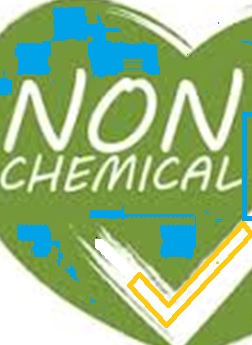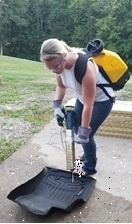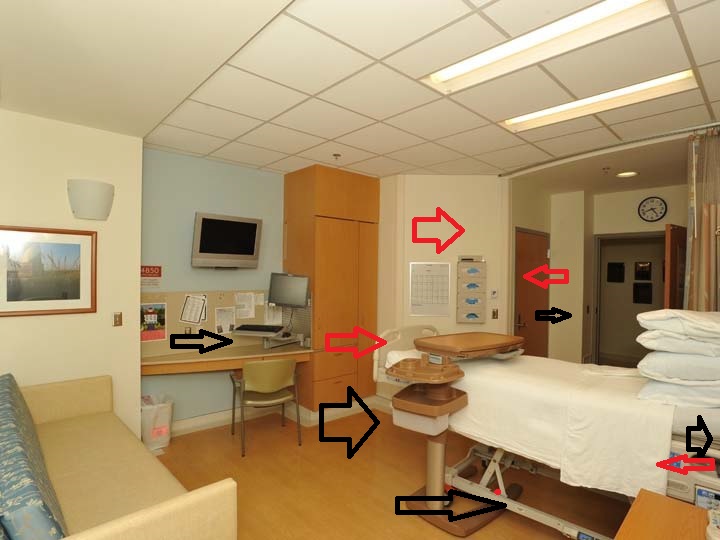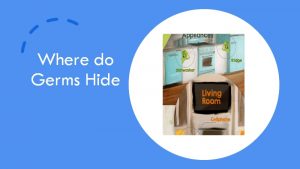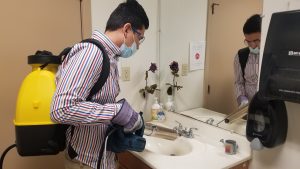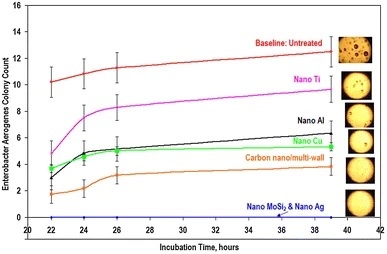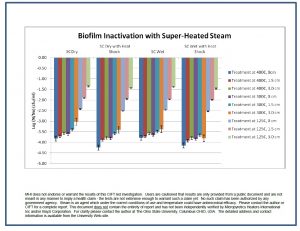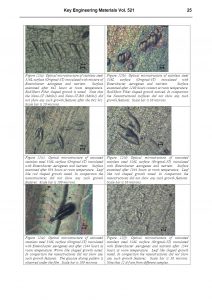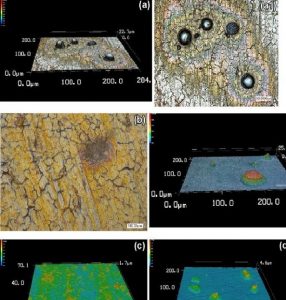
Aug 21, 2020 | News
Why is it important to clean the environment?
Microorganisms (bacteria, fungi, viruses) are present throughout our environment and can cause infection. The environment can serve as a breeding ground for these organisms. Cleaning and disinfecting housekeeping surfaces and medical equipment, especially those that are frequently touched, is important to decrease and/ or prevent the spread of these organisms to people particularly if they are rapid acting pathogens. Human fungal infections may fail to respond to contemporary antifungal therapies in vivo despite in vitro fungal isolate drug susceptibility. Such a discrepancy between in vitro antimicrobial susceptibility and in vivo treatment outcomes is partially explained by microbes adopting a drug-resistant biofilm mode of growth during infection. High efficacy methods of high temperature steam may be one of the few solutions for surfaces infested with biofilms.
What should I worry about when doing such cleaning? Cleaning is important. Having a regiment is important. Preventing the spread of toxic chemicals is important. If you are a restaurant, rental car agency or any other commercial business it is also important to know the speed of removal and the frequency of the regiment. High temperature steam is one of the fastest methods.
Resource for Cleaning:
For COVID-19 and many other viruses you need to leave on surface for 10 mins https://www.cdc.gov/coronavirus/2019-ncov/community/reopen-guidance.html# See also https://extension.colostate.edu/docs/pubs/foodnut/kitchen-sanitize.pdf See also https://www.pennmedicine.org/updates/blogs/health-and-wellness/2020/april/cleaning-against-covid See also https://www.pennmedicine.org/updates/blogs/health-and-wellness/2020/april/cleaning-against-covid
Warnings are sounding for the overuse of chemicals. https://www.ncbi.nlm.nih.gov/pmc/articles/PMC5685540/
Protecting the environment from a new problem from harsh and greasy chemicals, is beginning to cause serious worries. https://www.cnn.com/world/live-news/coronavirus-pandemic-05-16-20-intl/h_0f2325d2b58893ae656ac8e522afad79
https://www.vdh.virginia.gov/content/uploads/sites/3/2016/03/Environmental-Cleaning-Fact-Sheet.pdf

SaniZap-1

Aug 12, 2020 | News
The levels of clean
In a restaurant, there are at least three levels of cleaning: cleaning, sanitizing, and disinfecting and deep-cleaning. At the lowest level, cleaning means clearing dirt, trash, and debris from surfaces with a cloth. This makes the room and serving area look tidy and inviting, but it may not be enough to protect your guests. When done correctly, sanitizing kills 99% of bacteria, fungi, and some microbes. Sanitizing solutions must be mixed at the proper concentration and must be left on a surface for at least 60 seconds preferably more (but be aware of toxic chemicals). If you wipe down a table, menu, or serving counter with sanitizer and immediately dry it, you won’t get the full effect- you have to leave it there for minutes depending on the solution and dilution. Make sure your sanitizer does not cause corrosion. The highest level is sterility or close to ii is a good target. Some types of steam from rapid steam generators at high temperatures can get you there. But be careful not to burn anything. It is highly recommended that you work with a microbiologist if you wish these levels of cleaning. Be aware that sanitizers can cause damage. People use cloth or towels made of organic materials such as cotton or paper pulp. These materials break down sanitizer and will, over time, cause the solution to be ineffective. Rental Cars should be properly steamed with MightySteam for adequate residence.
High temperature steam like those obtained from SaniZap® act within a second to few seconds.
Use the cleanest possible methods for good hygiene. Routine cleaning and disinfecting are an important part of reducing the risk of exposure to COVID-19. Normal routine cleaning with soap and water alone can reduce risk of exposure and is a necessary step before you disinfect dirty surfaces.
Surfaces frequently touched by multiple people, such as door handles, desks, phones, light switches, and faucets, should be cleaned and disinfected at least daily. More frequent cleaning and disinfection may be required based on level of use. Source https://www.cdc.gov/coronavirus/2019-ncov/community/reopen-guidance.html#. For more information on Restaurants https://www.nrn.com/operations/how-should-restaurants-clean-coronavirus-cases.
One problem of using some type of sugar based chemicals are that it attracts not only microbes but also small creatures (bed bugs and ants). High temperature steam like the MightySteam® works on both microbes and bugs.


Hard To Reach Biofilms

Aug 11, 2020 | News
The Human Right to Water and Sanitation was recognized by the United Nations (UN) General Assembly in 2010. Sanitation is a global development priority. The estimate in 2017, 4.5 billion people currently do not have safely managed sanitation.
- In 2017, 45% of the global population (3.4 billion people) used a safely managed sanitation service.
- 31% of the global population (2.4 billion people) used private sanitation facilities connected to sewers from which wastewater was treated.
- 14% of the global population (1.0 billion people) used toilets or latrines where excreta were disposed of in situ.
- 74% of the world’s population (5.5 billion people) use d at least a basic sanitation service.
- 2.0 billion people still do not have basic sanitation facilities such as toilets or latrines.
- Of these, 673 million still defecate in the open, for example in street gutters, behind bushes or into open bodies of water.
- At least 10% of the world’s population is thought to consume food irrigated by wastewater.
- Cropland in peri-urban areas irrigated by mostly untreated urban wastewater is estimated to be approximately 36 million hectares (equivalent to the size of Germany)
- Poor sanitation is linked to transmission of diseases such as cholera, diarrhoea, dysentery, hepatitis A, typhoid and polio and exacerbates stunting.
- Poor sanitation reduces human well-being, social and economic development due to impacts such as anxiety, risk of sexual assault, and lost educational opportunities.
- Inadequate sanitation is estimated to cause 432 000 diarrhea deaths annually and is a major factor in several neglected tropical diseases, including intestinal worms, schistosomiasis, and trachoma. Poor sanitation also contributes to malnutrition.
A history of Hygiene in UK is given
here. A few choice excerpts are given below.
1750 – A letter from Lord Chesterfield to his son urges the use of a sponge and warm water to scrub the teeth each morning. The recommendation of using one’s own urine in France was widely flouted by Fouchard, the French dentist. Gunpowder and alum were also recommended.
1834 – The 1834 London Medical and Surgical Journal describes sharp stomach pains in patients with no evidence of disease. This led them to believe “painter’s colic” was a “nervous affection” of the intestines occurring when lead “is absorbed into the body”.
1847 – A physician called Ignaz Semmelwis found childbed fever occurred in women who were assisted by medical students. He found students who assisted in childbirth did so after autopsies. After instituting a strict hand washing policy, deaths dropped by 20 fold within 3 months.
1854 – In mid-18th century England, outbreaks of cholera led to an epidemic. A physician called John Snow observed that cholera seemed to spread via sewage-contaminated water. This was mostly noticed around a water pump in Broad Street, London. John removed the pump handle and the spread was instantly contained.
1858 – Hot weather struck the capital in 1858, drying up the River Thames and leaving pure sewage and other wasted piled up and exposed. This was the start of ‘The Great Stink’, forcing Parliament to close for the day and eventually initiating a reform of the sewerage systems and cesspits.
1861 – The modern flushing toilet. Thomas Crapper didn’t invent the flush toilet but is understood to have made major contributions towards its development by implanting a modern septic system that pumped soiled waters out of the city. However this particular subject is still heavily debated.
1920* – Lysol was sold as a genital disinfectant and birth control method. Lysol ads proclaimed a host of benefits for every gynecological need, and was the leading form of birth control from 1930 to 1960. Lysol is a poison that can cause burns and itches after the first drop.
*Source https://en.wikipedia.org/wiki/Lysol. “The first Lysol Brand Antiseptic Disinfectant was introduced in 1889 by Gustav Raupenstrauch to help end a cholera epidemic in Germany. The original formulation of Lysol contained cresols. This formulation may still be available commercially in some parts of the world. Formulations containing chlorophenol are still available in the United Kingdom.In 1911, poisoning by drinking Lysol was the most common means of suicide in Australia and New York. One of the active ingredients, benzalkonium chloride, is highly toxic to fish (LC50 = 280 μg ai/L), very highly toxic to aquatic invertebrates (LC50 = 5.9 μg ai/L), moderately toxic to birds (LD50 = 136 mg/kg-bw), and slightly toxic (“safe”) to mammals (LD50 = 430 mg/kg-bw)”.
1900’s – Autoclaves

Aug 6, 2020 | News
Biofilms are microbial communities that are tightly attached to surfaces and cannot be easily removed. Amazingly tiny microorganisms may be protected from disinfectants by production of thick masses of cells or biofilms. Once these biofilms form, microbes within them can be resistant to disinfectants by multiple mechanisms, including physical characteristics of older biofilms, genotypic variation of the bacteria, microbial production of neutralizing enzymes, and entropic gradients within the biofilm. Bacteria within biofilms are up to 1,000 times more resistant to anti-microbials than are the same bacteria in suspension. Several biofilms, or colonies of bacteria growing on surfaces and medical devices, can inflict intractable or recurring disease. During colonization, biofilms develop characteristics and behaviors more dangerous and powerful than those of planktonic (singleton) bacteria. Biofilm communities can develop within hours. Biofilms can propagate through detachment of small or large clumps of cells, or by a type of “seeding dispersal” that releases individual cells. Either type of detachment allows bacteria to attach to a surface or to a biofilm downstream of the original community. In addition to the protection offered by the matrix, bacteria in biofilms can employ several survival strategies to evade the host and chemical attack defense systems. Even inside human bodies by staying dormant and hidden from the immune system, they may cause local tissue damage and later cause an acute infection.
Can black mold films be removed with steam?
Pdf for biofilm elimination with steam.

Biofilm Elimination with steam
More Resources (with clickable links)
- https://www.cdc.gov/infectioncontrol
- Antimicrobial and Anti-Corrosive Efficacy of Inorganic Nano Porous Surfaces, Clean Technologies and Environmental Policies (CTEP), 845–857(2017)
- Nanostructured surfaces that show antimicrobial, anticorrosive, and anti-biofilm properties, KEM, Trans. Tech., Switzerland, vol. 521., pp. 1-33 (2012) (figure below is reproduced with permission from the article)

Biofilm rotation during formation

Biofilm elimination
Antimicrobial trivia
- Did you know that humans have over 10 trillion cells, over 10 trillion microbial cells, several billion bacteria and bacteriophages?
- Bacteria tend to be ~ 1-10 micrometers in size and can be seen with optical microscopes.
- Viruses can range from one to 500 nanometers in size. Powerful, high magnification electron microscopes are required to image them.
- The various coronaviruses sizes are about 50 nm nanometers (including the SARS CoV-2).
- Antibodies are of the order of 10 nanometers.
- Read about anti-microbial cleaning here.
- The size of the corona virus is (~50- 150 nm) (nm-nanometers).
- The size of spikes on the virus envelope ~20 nm
- Size of pores in a good respirator ~300 nm. This is why multiple layers are used.
- With chemical even a 10 minute soak is often required to denature a virus
- With high temperature steam this could be achieved in seconds
A nanometer is 10^-9 m (^ indicates – raised to the power of)
————————————————————————————–
More Dimensional Scales of Interest
- Average Diameter of the world: 12,792 Km (Km-kilometer)
- Deepest ocean trench: ~10,994 m (m-meter)
- Highest mountain: ~ 8,850 m
- Human scale: ~1 m
- Pencil tip: ~1 mm (mm-millimeter)
- Grain of salt: ~0.1-1 mm
- Bacterium: ~1-10 micrometer (10^-6 m)
- Atoms/molecules ~0.1 nm-100nm (10^-9 m)
- Electrons: ~10^-7 nm (nanometer)
- Planck’s length (quarks): ~10^-26 nm (smallest scale that is believed to exist in space-time)
Aug 4, 2020 | News
Although sadly the answer is maybe, there are ample ways of preventing it. Click for an excellent article.
Excerpt……
“The researchers identified more than 2,300 passengers known as “index patients” who developed COVID-19 within 14 days of their train trip, and more than 72,000 passengers who sat near these cases — within three rows (widthwise) and five columns (lengthwise) of the index patients.Overall, 234 of the 72,000 nearby passengers developed a COVID-19 infection linked to their train ride. That means the average “attack rate” — or percent who tested positive out of the overall group — was about 0.32%. Those who sat directly next to an infected person had the highest risk of contracting the infection, with an average attack rate of 3.5%.”
Keeping concentrations low of any pathogen is important.



